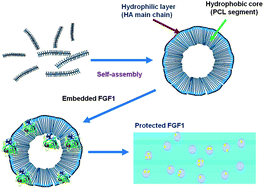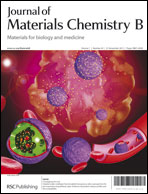Biodegradable micelles from a hyaluronan-poly(ε-caprolactone) graft copolymer as nanocarriers for fibroblast growth factor 1†
Abstract
A novel copolymer (HA-g-PCL) was prepared by grafting hydrophobic poly(ε-caprolactone) (PCL) chains onto the backbone of hydrophilic hyaluronic acid (HA) with a grafting ratio of ∼7%. The copolymer formed micelles with a size of ∼60 nm in aqueous solution over a critical concentration of ∼4 μg mL−1. Each micelle consisted of about four copolymer chains. Fibroblast growth factor 1 (FGF1) may be encapsulated in micelles by various methods. In particular, FGF1 loaded to micelles through 1-(3-dimethylaminopropyl)-3-ethyl-carbodiimide hydrochloride (EDC) conjugation provided efficient (∼87%) and large amount (up to ∼175 μg FGF1 per mg HA-g-PCL, or on average one FGF1 molecule per micelle) of loading as well as reduced burst release of FGF1. FGF1-loaded micelles remained functional after 21 days. Experimental rats receiving FGF1-loaded micelles showed better wound contraction and faster sebaceous gland formation than those receiving free FGF1 or empty micelles. We conclude that novel HA-g-PCL micelles are good nanocarriers for the controlled release of FGF1 and may be applied to encapsulate other bioactive molecules for therapeutic purposes.


 Please wait while we load your content...
Please wait while we load your content...